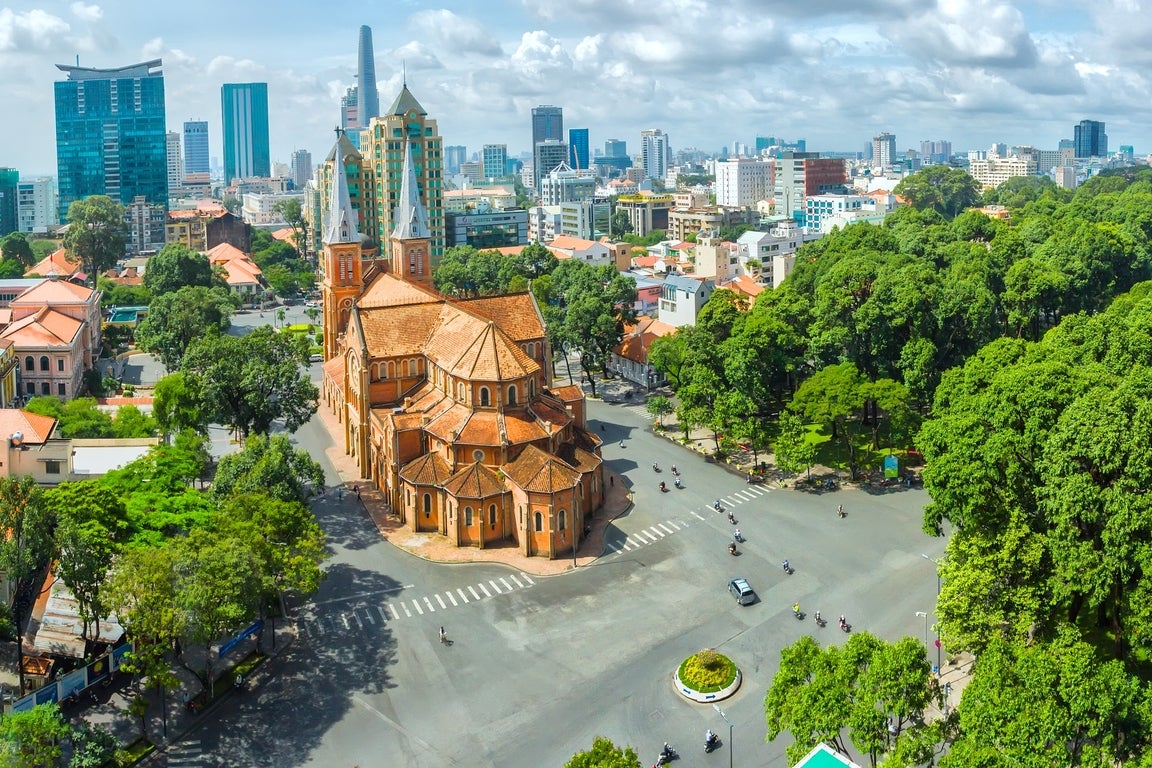Two scenarios for Vietnamese economy in 2021 and stellar expectations for 2022
 |
There is a saying that it is always darkest before the dawn. Fundamentally, this means one should not give up during hard times because things are hardest right before they start to get better. As a bank that has been in Vietnam for 151 years, we have been through ups and downs together with this country but we also know that Vietnam always finds a way to overcome obstacles and challenges. The national traits of perseverance and resilience will ensure this once again. Vietnam will prevail and the good times will return. We definitely believe this and despite this period of pain, we continue to have a positive outlook for the economy in the future.
We had high expectations for the economy this year after the strong performance in 2020 where Vietnam was one of the very few countries to evidence positive GDP growth as a result of a very effective handling of the pandemic. We all believed that the Year of the Ox, would bring in the same attributes as the Ox itself – strong, reliable, fair and calm after the frenzied Year of the Rat.
The year started very strongly with exports showing very strong positive momentum on the back of an opening up of the economies in the west who had been under lockdown in 2020 and the benefits of the large number of free trade agreements (FTAs) that Vietnam had signed started to bear fruit. The GDP growth forecast for the year by HSBC Global Research was 7.1 per cent and there was renewed confidence across the economy that this was eminently achievable.
 |
| Tim Evans, CEO of HSBC Vietnam |
What no one had predicted was that the COVID-19 virus would continue to mutate and mutate in a way that would make it far more virulent. Along came the Delta variant – a variant that spread so fast that it made it much harder to control. The impact of this variant as it spread across the country and in particular the economic heartland of Vietnam in the south, meant a swift re-introduction of lockdowns and travel restrictions. These in turn led to a decline in foreign direct investment (FDI) into the country. FDI in registered capital declined 11.1 per cent on-year in the first seven months of 2021 (a decline of 53.8 per cent in July alone).
However, on a more positive note, inflows of implemented capital were up 3.8 per cent on-year in the January-July period. The majority of the investment continued to be in the processing and manufacturing sector followed by electricity production and distribution.
Another impact of the lockdowns was that consumption took a significant hit. Retail sales fell by 19.8 per cent in July, the most since April 2020. Car sales dropped with passenger vehicle sales declining by 15.9 per cent on-year in June and commercial vehicle sales also dropped 1.8 per cent on-year.
The impact on the manufacturing sector intensified further in August and the ongoing restrictions lead to the temporary closure of certain businesses, while the social distancing measures and travel restrictions resulted in further declines in output, new orders, purchasing and ultimately employment. This in turn led to unprecedented supply-chain disruptions which were exacerbated by challenges around transportation and pressure on capacity at the country's ports. As a consequence, industrial production declined for the first time in five months due to weaker manufacturing output.
The current challenges are predominantly in the footwear and garment sectors, as it is the southeast region that has been hardest hit by the COVID-19 wave that is a major global manufacturing hub. Key global brands have seen challenges in their production, which is ultimately likely to affect Western consumers amid the holiday season. On a more positive note, mobile phone exports have stayed surprisingly resilient. This is due to the mobile phone assembly cluster being concentrated in the north, where operations have gradually returned to normal after being hit the hardest in May and June.
Unsurprisingly, the most recent August data reveals the pain that Vietnam’s economy is facing. The impact is significantly more severe than that during the 3-week national lockdown in April 2020. On the domestic front, private consumption saw a substantial hit, as mobility fell by as much as 60 per cent on average from the pre-pandemic levels. This has resulted in a 40 per cent reduction on-year in retail sales. The situation is even more acute in Ho Chi Minh City where people's mobility fell close to 90 per cent, leading to a 51 per cent drop in retail sales on a year-on-year basis.
HSBC’s current forecast for 2021 GDP growth has been amended to 5.1 per cent, reflecting the severe impact of the fourth COVID-19 wave.
The only way to come out of this situation is through active vaccination and ensuring that the medical professionals have the resources to handle those who are most adversely impacted from a health perspective by the virus.
After a faltering start, Vietnam has been able to obtain significant volumes of vaccines despite supply constraints impacting the world as production struggles to keep up with demand. Through a mix of effective ordering, lobbying, and donations, among others. The vaccine rollout programme has picked up pace with indications that the COVID-19 hotspot of Ho Chi Minh City has achieved administration of the first dose to nearly 90 per cent of the eligible population and a strong commitment to get a large majority of the population double vaccinated by the end of September.
The authorities are already talking about a gradual opening up of the economy and we forecast that this will start to gather pace from October onwards. The economic outlook by year end very much depends on the effectiveness of the vaccination rollout together with the effective and timely re-opening of the economy. However, I would not expect that we return to a totally normalised environment in the near future and therefore considering these factors, we are considering two scenarios for Vietnam’s economy until year-end:
Scenario 1: GDP growth in the range of 5-5.5 per cent, depending on the speed and effectiveness of the vaccination rollout, the re-opening of the economy and the recovery and resumption of major export markets, given the challenges posed by Delta variant.
Scenario 2: If the vaccination programme is not fast enough and lockdown and social distancing continue to be lengthened, there will be more adverse impact to the economy and there will be increased pressure on supply chains and GDP may only reach 3.5-4 per cent.
Either scenario, the economy needs to be re-opened, though in a cautious and systematic way. As in other markets, there tends to be a strong bounce back in economic activity at the time of reopening and we anticipate a similar outcome in Vietnam.
We believe consumption will bounce back sharply once the current COVID-19 wave subsides. In addition, the State Bank of Vietnam (SBV) has introduced reforms lately to help support the economy. It has increased credit growth for some commercial banks from an earlier 10-12 per cent to 14-15 per cent for this year and hopefully consideration may be given for a further increase to support the corporate sector. This will help banks to lend additional loans that can help to counter the slowdown as lockdowns and social distancing have drained corporate cashflows. The central bank has also advised that the lending interest rates for business and people hit hard by the pandemic should be lowered. In response, 16 commercial banks have reduced interest rates on existing loans which should help corporates with their cash flows.
As the economy starts to reopen, supply chain challenges should subside, orders will resume and FDI should resume its cadence given stable government with consistent policies, hardworking/resilient workforce, large number of FTAs and a commitment from the government to spend 7 per cent of GDP on continuing to develop infrastructure.
Despite the current environment, Vietnam remains a highly attractive investment destination in the medium term. This is based on the country’s robust fundamentals which many investors will look through the present COVID-19 volatilities. South Korean investors who know the market well are continuing their investments. Samsung is set to expand its phone plant as early as the second half of this year, aiming to ramp up its foldable phone production by 47 per cent to 25 million. While LG Display has just received approval for an additional investment of $1.4 billion in its Haiphong plant.
As more economies start to open up in the region on the back of large scale vaccine rollout, this coupled with the ongoing demand from the Europe and North America should see positive impact on the exports of technology related products, machinery, footwear, garments, furniture, food, and agricultural products.
The pandemic has accelerated the trends of automation and digitalisation and therefore Vietnam stands to benefit from this as a significant global producer of tech-related products.
Vietnam’s strong fundamentals remain and the country has built an enviable position in the global supply chain over the past years through its set of FTAs. Strong foreign currency reserves coupled with a stable currency, inflation being under-control, continued strong FDI inflows with an emphasis on the manufacturing sector all position Vietnam will for the future. As a result, HSBC is forecasting GDP growth of 6.8 per cent in 2022 with a bullish outlook for the mid and long term.
Our guidance to our customers is that we need to look through this short term pain and to start to plan for the future when we come out the other side of this terrible pandemic. There will be opportunities, there will be economic growth, Vietnam will bounce back and once again prove that when it comes to overcoming a challenge or obstacle, no one does it better than Vietnam.
What the stars mean:
★ Poor ★ ★ Promising ★★★ Good ★★★★ Very good ★★★★★ Exceptional
Related Contents
Latest News
More News
- Global partnerships key to Vietnam’s IFC development (December 26, 2025 | 16:18)
- Vingroup pulls out of bid to invest in North-South high-speed railway (December 26, 2025 | 11:42)
- Strengthening supply chains through trade promotions and customs reform (December 24, 2025 | 14:00)
- PM orders investment model for North–South high-speed rail (December 22, 2025 | 17:43)
- LS Eco Energy to invest in Vietnam rare earth sector (December 22, 2025 | 17:31)
- Government moves to establish International Financial Centre (December 21, 2025 | 21:00)
- Vietnam's IFC to target global investment flows (December 21, 2025 | 18:00)
- Two national hospitals expand capacity with new facilities (December 20, 2025 | 09:00)
- Ha Tinh breaks ground on major Vingroup industrial and energy projects (December 19, 2025 | 18:24)
- EVN launches major power infrastructure projects nationwide (December 19, 2025 | 18:17)

 Tag:
Tag:

























 Mobile Version
Mobile Version